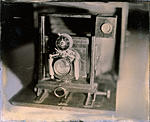Finally on track. Yesterday I was able to made some more plates, both tintypes & ambrotypes (4x5) and worked quite fine. Even as I was forced to use my only UV light as it was dark already. Here's one of the images. In fact is maybe the first wet plate fully made on my own: my salted collodion, (almost) my silver bath, my developer & my sandarac varnish!




 Reply With Quote
Reply With Quote


Bookmarks